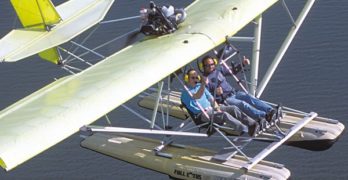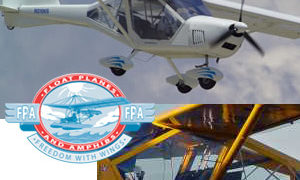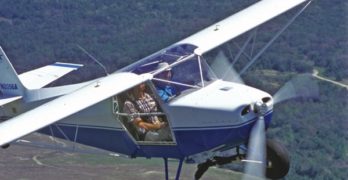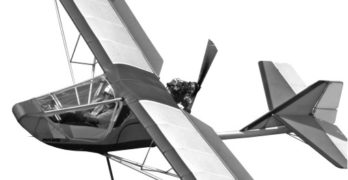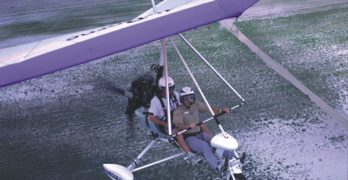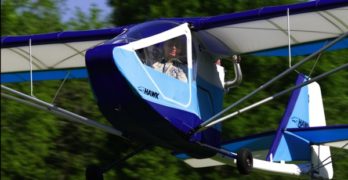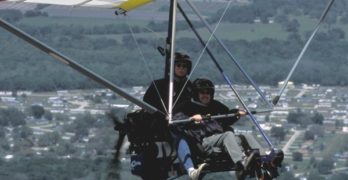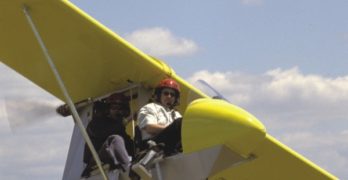A couple of years ago, TC’s Trikes owner TC Blyth and North Wing owner Kamron Blevins joined forces in a cooperative arrangement. TC’s Trikes would buy wings from North Wing (rather than continue to make their own), and could better represent North Wing on the Eastern Seaboard. North Wing, headquartered in the northwestern state of Washington, is far from TC’s Trikes’ Tennessee home. It seemed a marriage of convenience and more.
Blyth has been particularly active in training and introductory flight lessons. He’s done many thousands of them at his location near a top Tennessee tourist and outdoorsmen attraction – the Ocoee River, popular for white water rafting, kayaking, and other sports. Blyth has been focused on meeting this need with his own brand of trikes, and all his experience gave him something clear and viable to add to the expertise of North Wing.
North Wing has risen to the top of the U.S.
Search Results for : electric
Not finding exactly what you expected? Try our advanced search option.
Select a manufacturer to go straight to all our content about that manufacturer.
Select an aircraft model to go straight to all our content about that model.
Float-Flying the M-Squared Sprint 1000
“Air in your hair!
Space on your face! A breeze on your knees!” A former colleague of mine used to repeat this short mantra to illustrate the joy of open-cockpit flying. It was catchy and engaging and his customers liked it.
With 15 Light-Sport Aircraft now possessing their FAA Special Light-Sport Aircraft (SLSA) airworthiness certificates, not a single one is open cockpit, though the IndUS Thorpedo, Legend Cub, and Tecnam Sierra can enjoy partially open cockpits.
Special Light-Sport Aircraft will eventually add more of this genre of light aircraft but one of the beauties of FAA’s new regulation is that it does not eliminate two previous categories: Amateur-built 51% kits or Part 103-compliant ultralights.
With 21¼4 years left before operators of 2-seat 496-pound empty weight ultralight exempt trainers must register in FAA’s new Light-Sport Aircraft category, and with 41¼4 years left while these machines can be used for compensated training flights, the segment still has lots of life remaining.
U.S. Built A-22 Valor Wins SLSA #49
After I flew the A-20 and A-22 near Aeroprakt’s Ukraine factory, I felt sure these designs would find their way to the U.S. market. Now that Sebring-based Float Planes and Amphibs (FPNA) assumed import operations from Spectrum Aircraft, you can buy planes like the great-flying A-20 Vista or the tractor engine amphib A-24 Viking. FPNA also builds an amphibious float system for trikes and sells other lines like Quicksilver ultralights and powered parachutes. *** But their newest achievement on March 31st, a couple weeks before Sun ‘n Fun 2007, was SLSA approval for the A-22 Valor. FPNA is the manufacturer of this model, purchasing the fuselage and selected other components from designer Aeroprakt in Ukraine, but building 60% of the airplane themselves including wings, avionics and panel work, engine installation, plus all plumbing and electrical. FPNA owner Shawn Okun says the Orlando MIDO office gave their approval.
Just Aircraft’s Highlander
If you’re familiar with Avid Flyer or Kitfox aircraft, you know at least something about Just Aircraft’s Highlander. Its pedigree “path” is somewhat meandering but leads to an excellent flying machine born of a rich American airplane design heritage.
Dean Wilson was the originator of this now-proven design shape. The first departure from Wilson’s Avid Aircraft company was Dan Denney, who went on to offer the Kitfox. Denney’s prowess as a marketer brought international fame to the Kitfox and, over the years, the sale of nearly 3,000 aircraft. At one time Denney Aerocraft was among the country’s largest suppliers of kit-built aircraft. What had been an ultralight design evolved into a successful 2-seat homebuilt, but that wasn’t the end of the evolution behind Wilson’s original creation. Denney sold his company to Phil Reid, who renamed the Idaho company SkyStar.
A Well-Evolved History
Another break-off from Avid Aircraft and Denney Aerocraft was Flying K Enterprises, which introduced the single-seat Sky Raider.
CGS Aviation Makes Hawk
Remember why we fly ultralights? Few general aviation airplanes are flown below 1,500 feet above the ground. More rare is flight at 500 feet or 50 feet. Neither do you tend to fly most light-sport aircraft (LSAs) at these denser altitudes. Most flights in general aviation or LSA planes start out climbing high as quickly as possible. You switch on the autopilot as soon as possible and fiddle with the throttle, prop and mixture controls to squeeze all the fuel economy you can while flying as fast as the machine will manage in the straightest possible line all the way to your destination.
That’s fine for general aviation or LSA flying, and it’s enjoyable in a different way. But it isn’t ultralight flying.
What about just “boating around” the sky at your leisure, turning every few minutes to see the sights only possible from an ultralight aircraft. Your eye catches an alligator off to one side and you bank quickly to check it out.
AirBorne’s Edge X Wizard Trike
For years now, the boys from “down under” at AirBorne Australia, led by co-owner Russell Duncan, have been coming to America. The ultralight they have been showing is the deluxe Edge Executive model. It’s a beauty, but the company lacked a simpler, lower-cost model. No more!
In April of last year, Duncan and crew debuted what they call the Edge X Wizard model. The “Edge X” series refers to the new trike carriage, above which you can have the double-surface Edge wing, making the Executive trike, or you can select the new single-surface Wizard wing. It is this new offering that is the focus of this pilot’s report.
Smoothly finished in all-white powder coating, and lacking the nose pod and aft fairing, the new Edge X trike carriage looks light and basic. At only $11,700 fully assembled, it should find a market in the USA, I feel. (The figure is complete in every way except for an import shipping charge, which U.S.
CGS Pulls Out the Stops
… to keep the Hawk Ultra Light
Genuine ultralights still
have a place. These
aircraft|excuse me,
ultralight vehicles,
the least-FAA-regulated
flying machines,
will not be sent to aircraft boneyards
despite what some light-sport aircraft
skeptics may think. The Hawk Ultra
is proof positive CGS Aviation loves
ultralights and wants you to have fun
in the air.
No matter the pros and cons of
the sport pilot/light-sport aircraft (SP/
LSA) rule, operating a Part 103 ultralight
remains simpler than earning a
sport pilot certificate and buying an
LSA. No certificate, no medical, and
no registration is needed (though, it is
recommended that folks register with
one of the three associations supporting
ultralights-EAA, the United States
Ultralight Association (USUA), and Aero
Sports Connection (ASC). Additionally,
an ultralight can be fully factory built
without FAA inspections. The list of 103
privileges goes on, and the Hawk Ultra
qualifies for all of them.
One-Oh-Three Interest Soars
I don’t know about the “build it
and they will come” premise when
it comes to baseball fields, but I fervently
believe that if enough customers
want a product, someone will supply
it.
TC’s Trikes and North Wing Team Up on Coyote
Two years ago, I flew and reported on the only model TC’s Trikes offered. Though their line had little depth, the Tennessee company built their own wing and chassis. Many trike chassis builders purchase wings from other sources, much like happens universally in powered parachutes. TC’s Trikes did it all based particularly on their needs as an active flight school operation.
In today’s light aircraft world, a wider product line addresses more pilots, which makes a more viable business. Given the pace of refinements, it can be tough to keep up. Yet TC’s Trikes had a track record in the East, selling more than 100 trikes of their own and other brands. Pairing up with another company, if the fit was right, could be smart business.
A match was found between TC’s Trikes and Washington state-based North Wing Design. TC’s Trikes had something North Wing lacked – a presence in the Eastern USA.
Boathull Corsario Arrives in America
Brazilian Amphibious Beauty
Most Americans
are unaware of the Corsario. Importer Steven Cohen is out to change that. He and his partner, Phil Klein, are marketing this handsome amphibian, which they import from Brazil. Not a brand-new design, this is the MK5 model – it’s been through four previous iterations.
The Corsario comes from a South American company called Microleve founded in 1982, back near the beginning of the ultralight era. The company proudly states, “Aside from being the first ultralight manufacturer in Brazil, the quality of our products has made Microleve the biggest seller of ultralight aircraft in Latin America.”
In 23 years of operation, Microleve claims to have delivered more than 1,400 ultralight aircraft, including almost 20 different models, named as MX1, MX2, ML200, ML300, ML300M, ML300MF, ML400, ML400T, ML450, ML500T, CORSARIO MK1, MK2, MK3, MK4, and MK5. As you might surmise by reviewing this list, the Brazilian company has taken several of their models through a series of refinements and the Corsario is no exception.
The Lil’ Breezy B-Model
Open-Cockpit 2-seater
ust when you felt as though Light-Sport Aircraft (LSA) was the only segment of aviation getting any press, along comes a flying machine that harks back to the early days of ultralighting but with a distinctive fuselage construction and composite wings.
Just when it seemed like every new LSA had to be enclosed, four-stroke-powered, fast, and have leather seats, along comes a new open-cockpit, mile-a-minute airplane that can easily carry two people on the power of a 50-hp Rotax 503. The leather is on your flight jacket.
The Lil’ Breezy B can weigh 350 pounds empty, fly at 60 mph, and sell for $12,500 (for all parts plus engine/prop but not your assembly labor). In my experience that sounds like an ultralight. Born in the new millennium, the Lil’ Breezy B is a modern ultralight.
Before we go fly, let’s examine the machine and talk to its developer, Jack Harper.
- « Previous Page
- 1
- …
- 51
- 52
- 53
- 54
- 55
- …
- 67
- Next Page »



